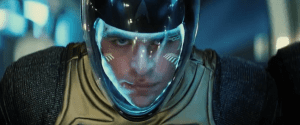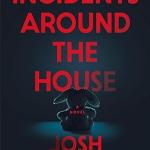 It was two months ago today that Star Trek into Darkness opened to the general public in Australia and other countries overseas, and this past weekend marked the first time that the film slipped out of the weekly top ten at the North American box office. So now seems like as good a time as any to link to a few Star Trek-themed things that weren’t online yet when I last wrote about the film.
It was two months ago today that Star Trek into Darkness opened to the general public in Australia and other countries overseas, and this past weekend marked the first time that the film slipped out of the weekly top ten at the North American box office. So now seems like as good a time as any to link to a few Star Trek-themed things that weren’t online yet when I last wrote about the film.
First, over at the Hogwarts Professor website, Elizabeth Baird Hardy has a really interesting post on the lack of literary allusions in the J.J. Abrams films:
Though I enjoyed the film very much, I noticed that it was loaded with plenty of wonderful allusions to other pieces of the Star Trek universe, but somewhere along the way, had lost one of the most important features of that universe: its deft use of literary allusions. . . .
Since one of the main reasons I like Star Trek is its use of literature familiar to us in our own century, I was delighted to have the chance to explore the use of historical literature in Star Trek and History (this is part of Wiley’s Popular Culture and history series, which also includes Twilight and History and Harry Potter and History). In addition to noting that Shakespeare is more important than Einstein in the creation of this fictitious future, I really enjoyed analyzing the way in the which Star Trek II: The Wrath of Khan linked up the protagonist and antagonist with particular literary texts. While in the original series episode that introduced Kahn, “Space Seed,” he quotes Milton’s Satan and the famous declaration that it is better to reign in Hell than to serve in Heaven, in the film, the bitter, revenge-fueled Khan has traded Paradise Lost for Moby Dick; Admiral James T. Kirk receives a copy of A Tale of Two Cities as a birthday gift from his friend Spock at the beginning of the film. These two great books dictate the entire arc of the film with quotations, plot elements, and the pivotal final choices of the main characters. . . .
I hope I am not letting the Tribble out of the bag to reveal that Star Trek into Darkness is a reboot-universe version of the events in Wrath of Khan. . . . While Kirk still loves his antiques, including a hi-fi system that he cranks up when he is entertaining ladies of questionable moral virtues and species, his book is gone. Unless I missed it (possible; those alien girlfriends pretty much steal the scene) I didn’t even see a book under glass (like Picard’s Shakespeare in his office) or on a shelf. Though the film is well done, entertaining, and usually satisfying, I am deeply troubled by the lack of literary allusions. While Kirk has kept his sass, swagger, and little black book, he has lost his tendency to quote literature, no longer telling Sulu to aim for the second star to the right and straight on ’til morning or asking for a tall ship and a star to steer her by. . . .
This is an excellent point — especially in light of the fact that the original Kirk was so studious that he was known, in his own Starfleet Academy days, as “a stack of books with legs” — and it underscores yet another way in which the Abrams films have been found lacking when compared to previous versions of this franchise.
It also adds a new wrinkle to the complaint many Star Trek fans have made, to the effect that Star Trek into Darkness borrowed way too heavily from previous Star Trek stories, and from one Star Trek story in particular. For a typically thorough (and occasionally NSFW) example of this complaint, see the video below:
To be fair, Star Trek has always alluded to non-literary forms of popular culture, going back to Gene Roddenberry’s original pitch for a TV show that would be like “Wagon Train to the stars”, and it has certainly recycled elements from previous stories before, going back to the very first movies: Star Trek: The Motion Picture (1979) earned the nickname ‘Where Nomad Has Gone Before’ because its central storyline resembled that of ‘The Changeling’, a 1967 episode that featured an artificial intelligence named Nomad; and of course, Star Trek II: The Wrath of Khan (1982) brought back Khan himself. But at their best, there was always something more to these films than self-regurgitation, and that “something more” is missing here.
Incidentally, Baird Hardy also notes that The Wrath of Khan wasn’t the only Star Trek movie to quote Moby Dick. Discussing how literary allusions can “work” even for people who have never read the alluded-to texts in question, she writes:
Of course, there is no reason we can’t just enjoy a book or a movie without picking up on the allusions. I am not a literary snob, so I don’t mind if someone just thought Ricardo Montalban was over-the-top amazing as the original Khan without realizing that some of those great lines originated in a hunt for white whale, rather than for a starship. In fact, that’s part of the fun. Sometimes we unconsciously pick up on allusions, only to later match them up or discover the book from when they hail. In Star Trek: First Contact, Lily plays the Ahab card to shock Picard into realizing that his actions are a “whale hunt” as irrational as Ahab’s, but then, when he quotes the novel, she admits, “I’ve never read it.”
At the risk of hopping off on yet another tangent, this reminds me of a really interesting point made by the authors of Deep Space and Sacred Time: Star Trek in the American Mythos, who noted that the two Moby Dick references actually show how the way a story affects a reader can often depend on what the reader brings to the text: in The Wrath of Khan, Khan is so egotistical he can only use the story to buttress his own obsessive hate, whereas in First Contact, Picard is self-aware enough — and open enough to the deeper meaning of a story like Moby Dick, thanks to years spent cultivating his own soul — that a reference to the story can snap him out of his obsession and allow him to look at his situation from a fresh perspective.
Okay, back to Star Trek into Darkness.
Three years ago, I wrote a blog post listing five reasons why it would be a bad idea to put Khan in this movie. And, now that we all know Khan is in this movie, I figured I’d take a look back and see how my warnings compare to the finished film.
First, I expressed concern that the Khan of this movie would have to be more like the Khan of the TV show than the Khan of the previous movies, and I stated that “Kirk-Pine would have to find Khan in pretty much the exact same condition that Kirk-Shatner found him in.” Well, the movie got around this, to some degree, by having someone else find Khan first — so we thankfully didn’t get a beat-for-beat replay of ‘Space Seed’. Instead, the Khan played by Benedict Cumberbatch already has a year or two of back-story unique to the new timeline when we first meet him — so if his personality seems different now, we can always chalk that up to his experiences with Section 31, which never happened on the original timeline. (I am less sanguine about the changes they’ve made to Khan’s physical strength etc. — as I noted here, Khan-Montalban could apparently be knocked out by a Vulcan nerve pinch, but Khan-Cumberbatch can’t — but I suppose even that could be chalked up to scientific experiments performed on him by Section 31 or something. Hey, if Khan’s DNA, or the DNA of his fellow augments, can be part of the explanation for why Klingons sometimes have bumpy heads and sometimes don’t…)
Second, I said that Spock-Nimoy should be warning Starfleet or Spock-Quinto about all the various threats he encountered on the original timeline, including Khan. Spock-Nimoy should be doing what he can to make sure that the threats of the original timeline are averted on this one. Well, the new movie did bring Spock-Nimoy back, but his appearance had the exact opposite effect on the film: instead of sending the story in a newer, more unpredictable direction, his cameo marks the exact point at which Star Trek into Darkness turns into a ham-fisted karaoke musical-chairs re-enactment of the climactic scenes from The Wrath of Khan.
Third, I noted that Khan was always supposed to be part of a race of genetically-engineered, power-hungry tyrants who fled our planet sometime in the 1990s. Khan first appeared in a 1967 TV episode, and he then came back in a 1982 movie, so his back-story was always somewhere in our future when those stories were told… but now, here we are in the 21st century, and the future predicted by those stories never happened. So would the new movie stay true to the character’s roots? Well, as it happens, the movie largely avoids getting into this in any detail — though it does say Khan is 300 years old, which is actually more accurate than the “200 years” that were typically cited in the earlier stories, which were written before the chronology of this series had been nailed down. So, the character’s 20th-century roots are there if you’re looking for them — but unlike the characters in ‘Space Seed’, who knew Khan’s history and were excited by the opportunity to learn more about the 20th century by interviewing Khan personally, the Kirk and Spock of Star Trek into Darkness don’t recognize Khan at all. Which makes the moment when Benedict Cumberbatch says “My name… is… Khan” even more anti-climactic than it already was.
Fourth, I asked if the new movie series was ever going “to be its own thing, or is it forever going to be aping the original series?” Well, as you can see from the video above, the Abrams films are actually aping not just the original series, but all the other Star Trek series, too. So, make of that what you will.
Fifth, I noted that the first Abrams film has “already borrowed several elements from Wrath of Khan” and that the next movie “should probably find a new well to drink from.” As it stands, I’m almost inclined to come up with a list of story elements from The Wrath of Khan that were not used by the two Abrams films, and to predict what the third film will be all about based on what Abrams hasn’t used yet.
And speaking of the third film… Paramount hasn’t announced anything yet, so we don’t know if there will be another sequel, but Star Trek into Darkness did reasonably well at the box office, so it certainly seems likely that there will be a sequel.
In raw, unadjusted dollars, Star Trek into Darkness is actually the top-grossing Star Trek movie ever made worldwide, largely on the strength of its performance overseas, where it has almost doubled what the previous film made.
But it still lags behind the 2009 film in North America — this, despite the boost from 3D ticket surcharges and four years of inflation — and its worldwide gross is a mere $444 million, or a little more than double the film’s production budget. (Compare this to the $600 million plus earned this summer by similar big-budgeted “franchise” movies like Man of Steel, Fast & Furious 6 and Iron Man 3.) So, once you knock off the cost of promoting the film, plus the percentage of the grosses that is kept by the theatres, it is quite likely that the film hasn’t made a profit yet.
For what it’s worth, Box Office Mojo estimates that Star Trek into Darkness would also lag behind Star Trek: The Motion Picture and Star Trek IV: The Voyage Home (1986) in North America if the grosses for all of these films were adjusted for inflation. (It would probably soar ahead of those films overseas, though, since the foreign markets weren’t anywhere near as lucrative back then as they are now.)
So, there’s a bit of good news and bad news there, from the studio’s perspective, with regard to how well the film has done in terms of box-office revenue and pop-culture profile. Will it all result in a third film? Who knows, maybe the studio is waiting to see how Star Trek into Darkness does on DVD and Blu-Ray.












